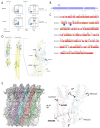Late Onset of Primary Hemophagocytic Lymphohistiocytosis (HLH) with a Novel Constellation of Compound Heterozygosity Involving Two Missense Variants in the PRF1 Gene
- PMID: 38474010
- PMCID: PMC10931657
- DOI: 10.3390/ijms25052762
Late Onset of Primary Hemophagocytic Lymphohistiocytosis (HLH) with a Novel Constellation of Compound Heterozygosity Involving Two Missense Variants in the PRF1 Gene
Abstract
Hemophagocytic lymphohistiocytosis (HLH) is a rare but in most cases life-threatening immune-mediated disease of the hematopoietic system frequently associated with hematologic neoplasms. Here, we report on a case in which we detected a novel constellation of two missense variants affecting the PRF1 gene, leading to de novo primary HLH. Diagnostics included a comprehensive clinical work-up and standard methods of hematopathology as well as extended molecular genomics based on polymerase chain reaction (PCR) reactions and the calculation of three-dimensional molecule reconstructions of PRF1. Subsequently, a comprehensive review of the literature was performed, which showed that this compound heterozygosity has not been previously described. The patient was a 20-year-old female. Molecular diagnostics revealed two heterozygous missense variants in the PRF1 gene (A91V and R104C) on exon 2. Apart from the finding of two inconclusive genetic variants, all clinical criteria defined by the HLH study group of Histiocyte Society were met at initial presentation. The final diagnosis was made in cooperation with the Consortium of German HLH-reference centers. Here, chemotherapy did not lead to sufficient sustained disease control. Therefore, the decision for allogenic hematopoietic stem cell transplantation (alloHSCT) was made. Hitherto, the duration of response was 6 months. Due to severe and unmanageable hepatic graft-versus-host disease (GvHD), the patient died. We report on a novel constellation of a compound heterozygosity containing two missense variants on exon 2 of the PRF1 gene. To the authors' best knowledge, this is the first presentation of a primary HLH case harboring this genomic constellation with late-onset clinical manifestation.
Keywords: PRF1 gene; compound heterozygosity; primary HLH.
Conflict of interest statement
The authors declare no conflicts of interest.
Figures


References
-
- Emile J.-F., Abla O., Fraitag S., Horne A., Haroche J., Donadieu J., Requena-Caballero L., Jordan M.B., Abdel-Wahab O., Allen C.E., et al. Revised classification of histiocytoses and neoplasms of the macrophage-dendritic cell lineages. Blood. 2016;127:2672–2681. doi: 10.1182/blood-2016-01-690636. - DOI - PMC - PubMed
Publication types
MeSH terms
Substances
LinkOut - more resources
Full Text Sources
Miscellaneous

